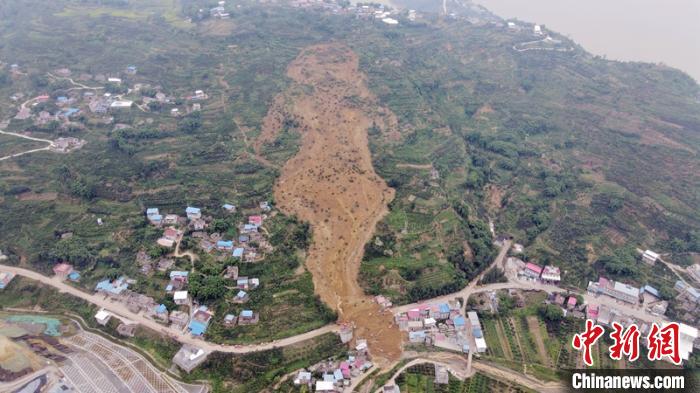20 October 2020
Hanyuan County: an initial analysis of the 21 August 2020 landslide in China
Posted by Dave Petley
Hanyuan County: an initial analysis of the 21 August 2020 landslide in China
On 21 August 2020 a significant landslide struck Hanyuan County in Sichuan Province, China, killing nine people. In a new paper published in the journal Landslides, He et al. (2020) provide an initial account of this event. It is impressive and unusual to produce a description of a landslide so quickly.
The image below, which was published by China News in the aftermath of the landslide, provides an impression of the scale of this failure:

Panoramic view of the Hanyuan County landslide, which occurred in August 2020 in Sichuan, China. Image from China News via Teller Report.
.
He et al. (2020) report that the landslide, which is located at 29.341, 102.698, had a volume of about 5 million cubic metres, and dimensions of 880 m long, 280 m wide and a depth of about 20 m.
Prior to the landslide, Hanyuan County suffered two substantial rainfall events, on 16 August 2020 and 18 August 2020, which together deposited 149.5 mm of precipitation. Interestingly, He et al. (2020) report the following local observations of the development of failure:
“According to our visit to local villagers, intermittent ground deformation in the landslide area has been observed since August 17, 2020. From August 17 to 18, numerous cracks have developed on the ground, and the length and width of cracks increased slightly. On August 20, a series of new cracks appeared in the rear edge of the landslide area, and the crack depth exceeded 1 m. At 3:50 am on August 21, the sliding materials began to slip along the sliding surface, accompanied by “swoosh” sound and the sky of dust.”
Note the quite long gap between the rainfall and the final failure event.
He et al. (2020) indicate that the failure in Hanyuan County occurred in three stages, which initiated at the top of the slope. This initial failure loaded the material further down the slope, which progressively failed. Finally, the entire slope failed and underwent a fluidisation process (presumably static liquefaction) to generate a high mobility flow that was devastating to buildings in its path.
Interestingly of course, if the population had been able to understand the precursory signs of failure that they were observing then loss of life might have been prevented. Building capacity of remote communities to understand these signals continues to be one of the great challenges in landslide work.
.
Quickslide 1: Improved models of landslide tsunami
EurekAlert has a good article about new research to improve the modelling of landslide tsunami, being undertaken in Russia.
.
Quickslide 2: Learning lessons from the hazards faced by mountain railways
India and Taiwan are sharing information about how to preserve mountain railways. Landslides have been a major problem in recent years for both the Darjeeling Mountain Railway in India and Alishan Forest Railway in Taiwan. Climate change, and in particular the increasing intensity of the most significant rainfall events, is going to be a severe threat in the decades ahead.
.
Reference
He, K., Liu, B. & Hu, X. 2020. Preliminary reports of a catastrophic landslide occurred on August 21, 2020, in Hanyuan County, Sichuan Province, China. Landslides . https://doi.org/10.1007/s10346-020-01566-5


 Dave Petley is the Vice-Chancellor of the University of Hull in the United Kingdom. His blog provides commentary and analysis of landslide events occurring worldwide, including the landslides themselves, latest research, and conferences and meetings.
Dave Petley is the Vice-Chancellor of the University of Hull in the United Kingdom. His blog provides commentary and analysis of landslide events occurring worldwide, including the landslides themselves, latest research, and conferences and meetings.
Does anybody else see a mermaid?